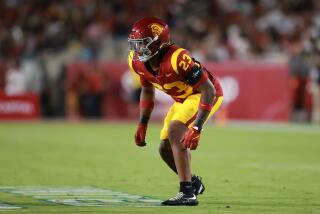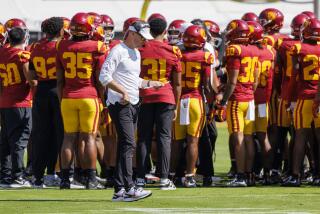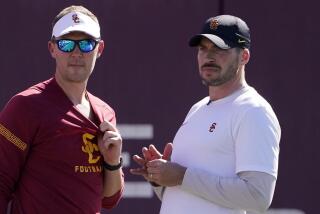Facing Tougher Scenes, ‘Backers Study Lines
They sit in a windowless room, lights dimmed, big guys squeezed into school desks, watching film of their next opponent. The same plays show over and over, from different angles.
In dense terminology, two assistant coaches chatter about schemes and responsibilities -- “There’s the Will. There you are scraping outside” -- using a laser pointer for emphasis. And this could be any film session, mind-numbing in its repetition, until one of the coaches jumps from his seat.
“What do you guys see here?”
He jabs a finger at the screen. The players, all linebackers, respond dutifully in a soft muddle of voices, but that isn’t good enough.
“Do you understand what we’re teaching?” the coach perseveres. He wants something more than rote answers.
“Why do we do it this way?”
Within the USC football program, coaches say they take pride in goading their players, demanding input, attempting to transform meetings into discussion groups. They go so far as to suggest there’s a little Socratic method lurking amid the Xs and O’s.
The players can’t help but notice.
“It’s like peer pressure,” weakside linebacker Keith Rivers says. “You’re going to get asked questions. Everyone in the room looks at you to see if you know what’s going on.”
This approach is particularly relevant to the linebacker corps, which lost two All-Americans last season and had its lone returning starter, Dallas Sartz, suffer a dislocated shoulder in the second game. The inexperienced group has faced added pressure because of a weakened secondary, the defense relying more heavily on zone coverage. The linebackers get less help against the run and must be ready to drop back in an instant.
That means assistants Rocky Seto and Ken Norton Jr. have their work cut out.
“We understand that we have young guys,” Norton says. “We have to coach them harder.”
*
“Check it out. Check it out.”
Seto does most of the talking in meetings, which are held in a room in the Heritage Hall basement, where photographs of such former Trojans as Duane Bickett and Junior Seau hang on the walls. At 29, Seto looks as fit as when he played linebacker for the Trojans, a career that ended with what he calls the “dubious” 1998 season, the year USC was upset by Texas Christian in the Sun Bowl.
The same qualities that allowed him to make the team as a walk-on -- he is unfailingly enthusiastic, likable -- helped him stick as a volunteer coach and work his way up the ladder.
On the Wednesday before the Arizona State game, he wants middle linebacker Oscar Lua to pay extra attention to film of the seam route. The Sun Devil receiver streaking down the middle of the field will be Lua’s responsibility.
“You see that?” he asks.
The middle linebacker, or “Mike,” serves as the quarterback of the defense, calling formations, making adjustments just before the snap. Afternoon meetings are crucial.
“The ‘backers watch the most tape out of all of us,” safety Scott Ware says. “Especially the middle linebacker ... he’s got to know everything.”
Lua arrived at USC in 2002 looking the part with blockish features, built like a fire hydrant. Seto calls him “a Dick Butkus-type.” But two knee surgeries set him back and he had to wait his turn behind All-American Lofa Tatupu, now in the NFL.
This summer, Coach Pete Carroll made a point of announcing that Lua would compete with younger players -- including freshmen -- for the starting spot. This did not sit particularly well with the redshirt junior, but he kept his mouth shut and won the job.
Through four games, he has made 22 tackles and drawn praise from his coaches. He also probably gets the most questions during film sessions.
It comes with the territory. The middle linebacker has to know his stuff.
“In the huddle, they’re all looking into your eyes,” Lua says. “You can’t stutter. You’ve got to be careful what you say ... and say it with authority.”
*
There could have been friction when Norton joined the staff last season. He arrived as a former UCLA star and All-Pro linebacker, not to mention a key member of three Super Bowl-winning teams, and was handed half of the job Seto had worked so hard to get.
But, Norton insists, “Rocky is a really special guy ... he opened his room to me.”
The two are nearly inseparable through long hours of coaching, lunches and dinners talking strategy. Players say the assistants have split the work along discernible lines, what Lua calls “hot and sour soup.”
Given his years at USC, his familiarity with the program, Seto leans more toward Xs and O’s. Norton, with a Kangol cap turned backward on his head, provides the electricity.
As soon as the players file out to the practice field he becomes an unequivocal presence. There he is in warmups, hopping, yelling, scrambling around in shorts.
When the team starts running plays and a ballcarrier breaks loose, Norton reverts to his playing days, giving chase, slapping at the ball. When Lua and Rivers take down a runner for no gain, the 39-year-old teases offensive line coach Pat Ruel, grabbing and wrestling with him.
Challenging his players to work harder, he screams: “Keep up with your coaches.”
This rowdiness fits with Carroll’s desire for a high-energy, high-volume staff. But Norton brings something else to the table -- his pro credentials give him status with players. As strongside linebacker Thomas Williams says: “The guy’s resume is so unbelievable that you just trust him.”
Norton’s influence can be essential in the development of players such as Rivers, who came to USC as a blue-chip recruit in need of polish.
“He’s got to be a guy who’s hungry, crazy for the ball,” Norton says. “No matter where the ball is, he’s going to be there, whether it’s technique that gets him there or he’s just hungrier than everybody else.”
Confidence is another issue. Far from his home in Lake Mary, Fla., Rivers needs to feel comfortable enough to trust his instincts and react quickly. He says he feeds off Norton’s encouragement.
The results have been promising, Rivers tied for the team lead with 24 tackles, two of them for losses.
“Each day gets a little easier,” he says. “I feel like I’m coming into my own.”
*
Early in the second quarter, Arizona State leads by a touchdown when Lua, remembering from film work that the Sun Devils like to roll left and throw to the backside receiver, intercepts a pass that leads to a USC field goal.
It is the first of several plays linebackers will make in helping the Trojans to a come-from-behind 38-28 victory over the 14th-ranked Sun Devils.
Midway through the third quarter, Lua comes up big again, stuffing a running back on fourth and one.
“We had to stop that drive,” he says. “I saw the line opening up, saw the running back put his head down and I shot my gap.”
A few minutes later, Williams, the outside linebacker, deflects a pass that is intercepted by cornerback John Walker. By day’s end, Rivers will have six tackles from his weakside, or “Will,” spot and backup Collin Ashton will have four.
“They were somehow always in position,” Arizona State quarterback Sam Keller says of the Trojan defenders.
Seto watches from the booth, trying to temper his natural enthusiasm, to remain analytical. Norton works the sideline where his passion and playing experience are best put to use.
In the final moments, with the Trojan defense backed up against the goal line, trying to protect a lead, he walks onto the field during a timeout.
Long shadows cut across Sun Devil Stadium, a 95-degree heat settling on the turf. This is an opportunity for the linebackers to prove they have been listening in meetings, working hard in practice.
Norton, known for his intensity and animation, speaks quietly. “It’s time to make a play,” he tells his guys. “It’s time to grow up.”
More to Read
Go beyond the scoreboard
Get the latest on L.A.'s teams in the daily Sports Report newsletter.
You may occasionally receive promotional content from the Los Angeles Times.







